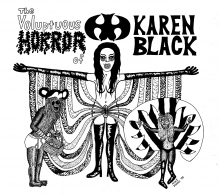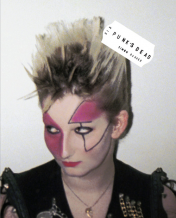| Umělec magazine 2003/1 >> Beauty Eternal 19. 5. - 5. 6. 2003, VŠUP, Prague | List of all editions. | ||||||||||||
|
|||||||||||||
Beauty Eternal 19. 5. - 5. 6. 2003, VŠUP, PragueUmělec magazine 2003/101.01.2003 Jan Kuneš | review | en cs |
|||||||||||||
|
Vít Soukup paints objects from everyday life of the 1970s in his paintings, which were recently exhibited in the show Krása nesmírná (Eternal Beauty), captured from photographs in the Slovak magazine Dorka. However Soukup’s paintings of photographs from Dorka are so disconcerting and desperate that it is immediately obvious that they do not constitute a pure representation of the magazine.
It is necessary to look for this desperate content elsewhere, while at the same time being aware that the content arises from pure representation of Dorka. At the same time, it is also necessary to take into account other elements in the contents of the painting, like the way they are painted. “It is an outright celebration of a cup of coffee,” I hear someone comment on the oil painting of two “modern” cups placed on tablecloths with a pseudo-folk pattern. I myself am smitten by a painting hanging nearby. Orange-white-blue round pseudo-folk needlework, which enters — literally burns — from a black impenetrable background, like the glowing disc of the sun in a dark, deadly night. The oils are painted with bright colors, which makes the captured things present almost unreal. In the final effect, there is what almost appears to be an abyss of distance between us and the paintings, causing them to look like a kind of distant mirage. One reason could be due to the “magnification” of the represented objects on the large-format canvases. However not all the paintings are this size, and so the impression of an unreal “veiling” of whatever is present must be based on something else. This is effect could be achieved through his perfect oil painting technique, which on the one hand captures the banal, everyday objects, while at the same time returning them to a state of nothingness. In such a painting, the expectation is to find things completely different, noble. Here the captured banalities don’t seem adequate to the methods of their capture. The same principle of returning objects to a state of nothingness could work, but only if the use of classical oil painting were understood to be a gesture of kitsch. Things made present here would, as a consequence, immediately pull back into an already closed up past, which kitsch in its obsoleteness represents. Myself I presume that what causes the objects in Soukup’s paintings to stand out with such urgent presence, while at the same time irrecoverably escaping, can be detected only after closer speculation of the connection with Dorka. This is a magazine that does not merely represent designs that are one to one in scale. Rather, it turns to its readers with suggestions on how to tastefully dress and furnish their homes. It is a challenge, an attempt to improve a given presence. It is necessary to add this magazine did not appear in a free market environment. It was not — as nothing was in the socialist economy — dependent on a market, thereby negating any suspicion that it might be ferociously pandering, trying to cadge as many promoters or possible buyers. Dorka seems to be entirely guileless. And perhaps only because of this naiveté it is harmonious in the general attempt that the era proclaimed, peaking in the seventies. This attempt was the advocated notion of making a world of better people, but most of all: making people themselves into those who “with their own hands” would be able to create their very own better world. Only the naive believed the truth of this proclamation in the time of Dorka, or perhaps those who ideologically manipulated even their own experiences. But even those who were not naive or brainwashed by ideology bought Dorka and saved it. It seemed that the era simply carried it and its designs. Even here very few were alert enough to consider Dorka an instrument of the regime. The rare few were able to tie it into the context of, for example, the 1950s when folklore was violently clenched in the pincers of the ideologists in order to be transformed and made into an official art that could be set as some kind of alternative to anything that might eventually come from the West. On the contrary, stupid pseudo-folklore provincialism was completely absorbed, so Dorka could make the proclamation with all naive sincerity of its sense for tradition. Its objective “modern” fads of wild patterns and colorful compositions, then, cover up the programmed provincialism, as they convinced readers of Dorka’s sense for the present time — here and there some things flashed out that might have appeared in a foreign journal. However, regardless of the content of Dorka, the isolated world achieved by the regime was already taken with the emancipating pursuit of “do it yourself.” Knitting sweaters. People were completely entangled and bound to each other from head to the heal — in love. Their children were even absorbed into their toils — see the picture of the boy on the scooter, who is entirely stuffed in his “cute” knitted suit of armor, the same colorful, heroic cap on his head: inspiration from the eastern provenience was certainly allowed. Despite the horror we now see in its naked form, because the era with its presence, covering up its repressive tools, has forever fallen into the background, there is also that which strongly draws us towards it, which is intoxicatingly beautiful, which is like a paradise lost. This is not a memory of those times, even though they may have been our childhood. It is rather the touch of dear ones, with whom we shared the lost world of Dorka, of the dear ones whose love introduced us to this world, because they wanted to furnish us in the best possible way, so they themselves also chose to sew, knit something for us. Those who created this world according to Dorka, and connected us to it, are not visible in the images. They disappeared like the era where the world according to Dorka had originated. About this era we cannot say more than: Thank God it’s over. However there are things left behind, as if enchanted. The presence of those who are not in the pictures is the light in which things stand still, so vitally and intimately in front of us, even though they are at the same time lost, just as those who bind us to the things in Dorka are also missing. They celebrated those things. And Vít Soukup, in the way he painted them, sees them for us.
01.01.2003
Recommended articles
|
|||||||||||||
|
04.02.2020 10:17
Letošní 50. ročník Art Basel přilákal celkem 93 000 návštěvníků a sběratelů z 80 zemí světa. 290 prémiových galerií představilo umělecká díla od počátku 20. století až po současnost. Hlavní sektor přehlídky, tradičně v prvním patře výstavního prostoru, představil 232 předních galerií z celého světa nabízející umění nejvyšší kvality. Veletrh ukázal vzestupný trend prodeje prostřednictvím galerií jak soukromým sbírkám, tak i institucím. Kromě hlavního veletrhu stály za návštěvu i ty přidružené: Volta, Liste a Photo Basel, k tomu doprovodné programy a výstavy v místních institucích, které kvalitou daleko přesahují hranice města tj. Kunsthalle Basel, Kunstmuseum, Tinguely muzeum nebo Fondation Beyeler.
|


































 New book by I.M.Jirous in English at our online bookshop.
New book by I.M.Jirous in English at our online bookshop.
Comments
There are currently no comments.Add new comment